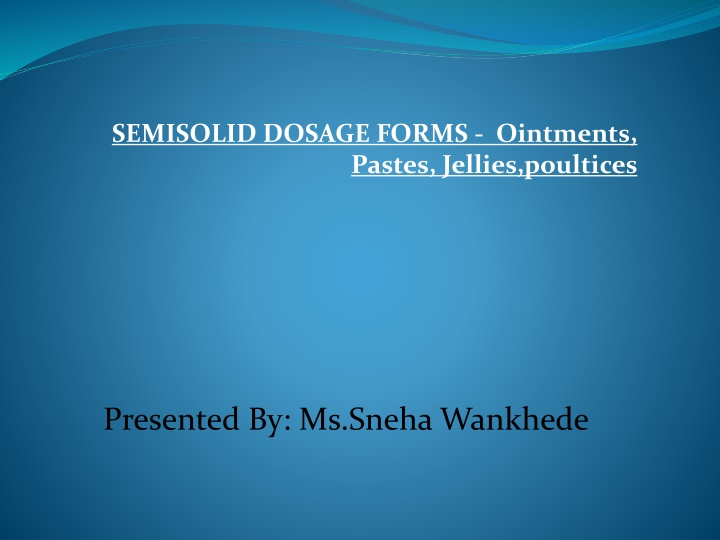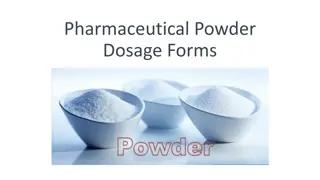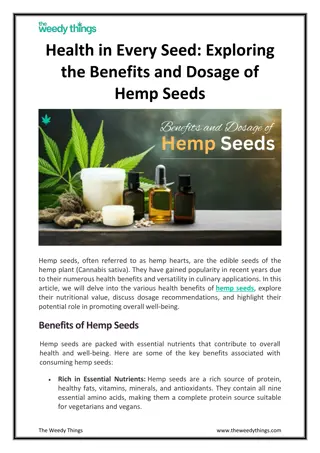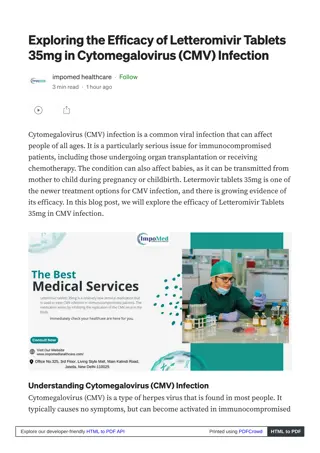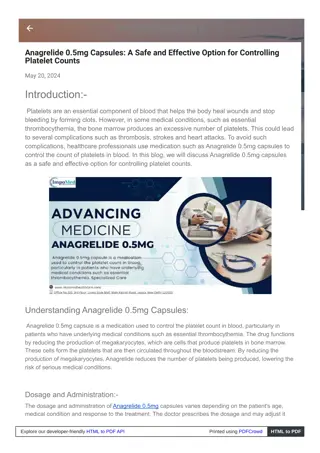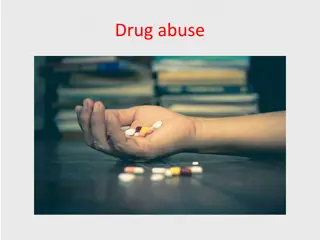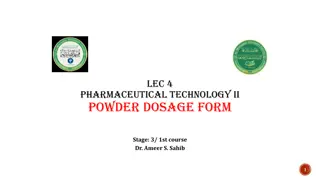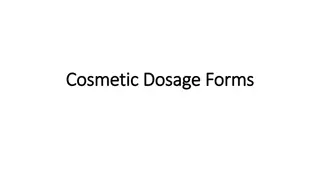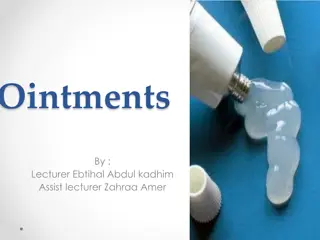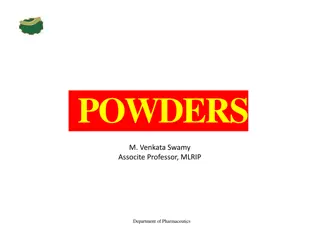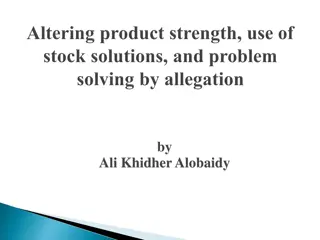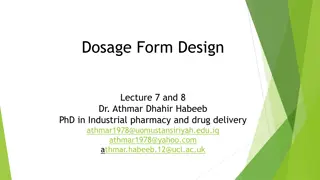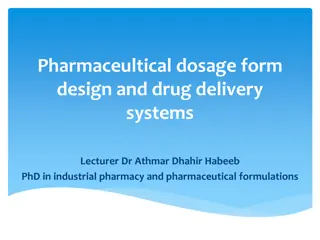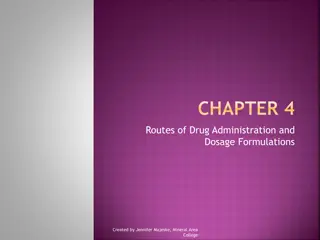Overview of Semisolid Dosage Forms: Ointments, Pastes, Jellies
Semisolid dosage forms such as ointments, pastes, and jellies are used for external application, providing protective and therapeutic actions. Ointments contain medicaments in suspension or solution, while pastes have a high proportion of powdered medicaments. Jellies are non-greasy and transparent. Ideal ointments should be stable, smooth, and free from grittiness, with medicaments finely distributed in a non-irritative base.
Uploaded on Sep 11, 2024 | 3 Views
Download Presentation

Please find below an Image/Link to download the presentation.
The content on the website is provided AS IS for your information and personal use only. It may not be sold, licensed, or shared on other websites without obtaining consent from the author.If you encounter any issues during the download, it is possible that the publisher has removed the file from their server.
You are allowed to download the files provided on this website for personal or commercial use, subject to the condition that they are used lawfully. All files are the property of their respective owners.
The content on the website is provided AS IS for your information and personal use only. It may not be sold, licensed, or shared on other websites without obtaining consent from the author.
E N D
Presentation Transcript
SEMISOLID DOSAGE FORMS - Ointments, Pastes, Jellies,poultices Presented By: Ms.Sneha Wankhede
content a) Ointments:-Type of ointments, classification and selection of dermatological vehicles. Preparation and stability of ointments (b) Pastes: Differences between ointments and pastes. Bases of pastes. Preparation of pastes and their preservation. (c) Jellies: An introduction to the different types of jellies and their preparation. (d) An elementary study of poultice.
Ointments Ointments are soft semisolid preparations meant for external application to the skin or mucous membrane. They usually contains medicament which is either dissolved or suspended in the base. They have emollient and protective action.
Creams are semisolid emulsions and are generally of softer consistency and lighter than ointments. They are less greasy and are easy to apply. Pastes are semisolid preparations for external application that differ from similar products in containing a high proportion of finely powdered medicaments. They are stiffer and are usually employed for their protective action and for their ability to absorb serious discharges from skin lesions.
Thus when protective, rather than therapeutic action is desired, the formulation pharmacists will favor a paste, but when therapeutic action is required, he will prefer ointments and creams. Jellies are transparent or translucent, non-greasy, semisolid preparation mainly used externally. The gelling agent may be gelatin, starch, tragacanth, sodium alginate or cellulose derivative (e.g. carboxy methyl cellulose).
OINTMENT Definition: Ointments are semisolid preparations for application to the skin or mucosa. The ointment bases are almost always anhydrous and generally contain one or more medicaments in suspension or solution.
Characteristics of an ideal ointment 1. 2. 3. It should be chemically and physically stable. It should be smooth and free from grittiness. It should melt or soften at body temperature and be easily applied. 4. The base should be non-irritant and should have no therapeutic action. 5. The medicament should be finely divided and uniformly distributed throughout the base
Classification of ointments According to their therapeutic properties based on penetration of skin. According to their therapeutic uses.
Ointments classified according to their therapeutic properties based on penetration are as follows: (a) Epidermic, (b) Endodermic, (c) Diadermic
(a) Epidermic ointments These ointments are intended to produce their action on the surface of the skin and produce local effect. They are not absorbed. They act as protective, antiseptic and parasiticide. (b) Endodermic ointments These ointments are intended to release the medicaments that penetrate into the skin. They are partially absorbed and acts as emollients, stimulants and local irritants. (c) Diadermic ointments These ointments are intended to release the medicaments that pass through the skin and produce systemic effects.
According to therapeutic uses the ointments are classified as follows: (i) Acne treatment (ii) Antibiotics microorganisms. e.g. bacitracin, chlortetracycline, neomycin. (iii) Antieczematous exudation from vesicles on the skin. e.g. hydrocortisone, coal tar, ichthamol, salicylic acid. (iv) Antifungal fungi e.g. benzoic acid, salicylic aid, nystatin, clotrimazole, etc. (v) Anti-inflammatory inflammatory, allergic and pruritic conditions of the skin e.g. betamethasone valerate, hydrocortisone, triamcinolone acetonide : resorcinol, sulfur. :Used to kill :Used to stop oozing and :Used to inhibit or kill the :Used to relieve
(vi) Antipruritic e.g. benzocaine, coal tar. (vii) Antiseptic ammoniated mercury, zinc oxide. (vii) Astringent glands or discharge from skin surface e.g. calamine, zinc oxide, aluminium acetate and subacetate, acetic acid and tannic acid. (ix) Counter irritant to irritate the intact skin, thus reducing or relieving another irritation or deep seated pain. e.g. capsicum oleoresin, iodine (Iodex), methyl salicylate. (x) Dandruff treatment :e.g. salicylic acid and cetrimide (cetyl trimethyl ammonium bromide) :Used to relieve itching :Used to stop sepsis e.g. :Reduces the secretion of :These are applied locally
(xi) Emollient (for example in the dry season) e.g. soft paraffin (xii) Keratolytic the horny layer of the skin e.g. resorcinol, salicylic acid and sulfur. (xi) Keratoplastic thickness of horny layer e.g. coal tar. (xii) Parasiticide or inhibit living infestations such as lice and ticks e.g. benzyl benzoate, gamma-benzene hexachloride (GBH), sulfur etc. (xiii) Protective moisture, air, sun rays or other substances such as soaps or chemicals. e.g. silicones, titanium dioxide, calamine, zinc oxide, petrolatum. :Used to soften the skin :Used to remove or soften :Tends to increase the :These ointments destroy :Protects the skin from
OINTMENT BASES The ointment base is that substance or part of an ointment preparation which serves as carrier or vehicle for the medicament. An ideal ointment base should be inert, stable, smooth, compatible with the skin, non-irritating and should release the incorporated medicaments readily. Classification of ointment bases: 1. Oleaginous bases 2. Absorption bases 3. Water-miscible bases 4. Water soluble bases
OLEAGINOUS BASES These bases consists of oils and fats. The most important are the Hydrocarbons i.e. petrolatum, paraffins and mineral oils. The animal fat includes lard. The combination of these materials can produce a product of desired melting point and viscosity. (a) Petrolatum (Soft paraffin) This is a purified mixture of semi-solid hydrocarbons obtained from petroleum or heavy lubricating oil. Yellow soft paraffin (Petrolatum; Petroleum jelly) This a purified mixture of semisolid hydrocarbons obtained from petroleum. It may contain suitable stabilizers like, antioxidants e.g. a-tocopherol (Vitamin E), butylated hydroxy toluene (BHT) etc. Melting range : 38 to 560C.
White soft paraffin (White petroleum jelly, White petrolatum) This a purified mixture of semisolid hydrocarbons obtained from petroleum, and wholly or partially decolorized by bleaching the yellow soft paraffin. Melting range : 38 to 560C. Use: The white form is used when the medicament is colourless, white. This base is used in Dithranol ointment B.P. Ammoniated Mercury and Coal tar ointment B.P.C. Zinc ointment B.P.C.
(b) Hard paraffin (Paraffin) This is a mixture of solid hydrocarbons obtained from petroleum. It is colourless or white, odorless, translucent, wax-like substance. It solidifies between 50 and 570C and is used to stiffen ointment bases.
(c) Liquid paraffin (Liquid petrolatum,; White mineral oil) It is a mixture of liquid , hydrocarbons obtained from petroleum. It is transparent, colourless, odourless, viscous liquid. On long storage it may oxidize to produce peroxides and therefore, it may contain tocopherol or BHT as antioxidants. It is used along with hard paraffin and soft paraffin to get a desired consistency of the ointment. Tubes for eye, rectal and nasal ointments have nozzles with narrow orifices through which it is difficult to expel very viscous ointments without the risk of bursting the tube. To facilitate the extrusion upto 25% of the base may be replaced by liquid paraffins.
Advantages of hydrocarbons bases: (i) They are not absorbed by the skin. They remain on the surface as an occlusive layer that restricts the loss of moisture hence, keeps the skin soft. (ii) They are sticky hence ensures prolonged contact between skin and medicament. (iii) They are almost inert. They consist largely of saturated hydrocarbons, therefore, very few incompatibilities and little tendency of rancidity are there. (iv) They can withstand heat sterilization, hence, sterile ophthalmic ointments can be prepared with it. (v) They are readily available and cheap.
Disadvantages of hydrocarbon bases; (i) It may lead to water logging followed by maceration of the skin if applied for a prolonged period. (ii) It retains body heat, which may produce an uncomfortable feeling of warmth. (iii) They are immiscible with water; as a result rubbing onto the surface and removal after treatment both are difficult. (iv) they are sticky, hence makes application unpleasant and leads to contamination of clothes. (v) Water absorption capacity is very low, hence, these bases are poor in absorbing exudate from moist lesions.
ABSORPTION BASE The term absorption base is used to denote the water absorbing or emulsifying property of these bases and not to describe their action on the skin. These bases (some times called non emulsifiable ointment bases) are generally anhydrous substances which have the property of absorbing (emulsifying) considerable quantity of water yet retaining its ointment-like consistency. Preparations of this type do not contain water as a component of their basic formula but if water is incorporated a W/O emulsion results.
Wool Fat (anhydrous lanolin) It is the purified anhydrous fat like substance obtained from the wool of sheep. It is practically insoluble in water but can absorb water upto 50% of its own weight. Therefore it is used in ointments the proportion of water or aqueous liquids to be incorporated in hydrocarbon base is too large. Due to its sticky nature it is not used alone but is used along with other bases in the preparation of a number of ointments. e.g. Simple ointment B.P. contains 5% and the B.P. eye ointment base contains 10% woolfat.
Hydrous Wool Fat (Lanolin) It is a mixture of 70 % w/w wool fat and 30 % w/w purified water. It is a w/o emulsion. Aqueous liquids can be emulsified with it. It is used alone as an emollient. Example:- Hydrous Wool Fat Ointment B.P.C., Calamine Coal Tar Ointment.
Wool Alcohol It is the emulsifying fraction of wool fat. Wool alcohol is obtained from wool fat by treating it with alkali and separating the fraction containing cholesterol and other alcohols. It contains not less than 30% of cholesterol. Use:- It is used as an emulsifying agent for the preparation of w/o emulsions and is used to absorb water in ointment bases. It is also used to improve the texture, stability and emollient properties of o/w emulsions. Examples :- Wool alcohol ointment B.P. contains 6% wool alcohol and hard, liquid and soft paraffin.
Beeswax It is purified wax, obtained from honey comb of bees. It contains small amount of cholesterol. It is of two types: (a) yellow beeswax and (b) white beeswax. Use:- Beeswax is used as a stiffening agent in ointment preparations. Examples:-Paraffin ointment B.P.C. contains beeswax.
Cholesterol It is widely distributed in animal organisms. Wool fat is also used as a source of cholesterol. Use:- It is used to increase the water absorbing power of an ointment base. Example:- Hydrophilic petroleum U.S.P. contains: Cholesterol 3% Stearyl alcohol 3% White beeswax 8% White soft paraffin 86%
Advantages of absorption bases: (i) emollient. (ii) They assist oil soluble medicaments to penetrate the skin. (iii) They are easier to spread. (iv) They are compatible with majority of the medicaments. (v) They are relatively heat stable. (vi) The base may be used in their anhydrous form or in emulsified form. (vii)They can absorb a large quantity of water or aqueous substances. Disadvantages: Inspite of their hydrophilic nature, absorption bases are difficult to wash. They are less occlusive nevertheless, are good
WATER MISCIBLE BASES They are miscible with an excess of water. Ointments made from water-miscible bases are easily removed after use. There are three official anhydrous water-miscible ointment bases:- Example:- Emulsifying ointment B.P. - contains anionic emulsifier. Cetrimide emulsifying ointment B.P.- contains cationic emulsifier Cetomacrogol emulsifying ointment B.P.- contains non-ionic emulsifier Uses: they are used to prepare o/w creams and are easily removable ointment bases e.g. Compound Benzoic Acid Ointment (Whitfield s Ointment) - used as antifungal ointment.
Advantages of water miscible bases: Readily miscible with the exudates from lesions. Reduced interference with normal skin function. Good contact with the skin, because of their surfactant content. High cosmetic acceptability, hence there is less likelihood of the patients discontinuing treatment. Easy removal from the hair.
WATER SOLUBLE BASES Water soluble bases contain only the water soluble ingredients and not the fats or other greasy substances, hence, they are known as grease-less bases. Water soluble bases consists of water soluble ingredients such as polyethylene glycol polymers (PEG) which are popularly known as carbowaxes and commercially known as macrogols . They are a range of compounds with the general formula: CH2OH . (CH2OCH2)nCH2OH
The PEGs are mixtures of polycondensation products of ethylene and water and they are described by numbers representing their average molecular weights. Like the paraffin hydrocarbons they vary in consistency from viscous liquids to waxy solids. Example:- Macrogols 200, 300, 400- viscous liquids Macrogols 1500 - greasy semi-solids Macrogols 1540, 3000, 4000, 6000- waxy solids. Different PEGs are mixed to get an ointment of desired consistency.
Advantages of PEGs as ointment base: (a) They are water soluble; hence, very easily can be removed from the skin and readily miscible with tissue exudates. (b) Helps in good absorption by the skin. (c) Good solvent properties. Some water-soluble dermatological drugs, such as salicylic acid, sulfonamides, sulfur etc. are soluble in this bases. (d) Non-greasy. (e) They do not hydrolyze, rancidify or support microbial growth. (f) Compatibility with many dermatological medicaments
Disadvantages: (a) proportion of water reaches about 5%. (b) Reduction in activity of certain antibacterial agents, e.g. phenols, hydroxybenzoates and quaternary compounds. (c) Solvent action on polyethylene and bakelite containers and closures. Limited uptake of water. Macrogols dissolve when the Certain other substances which are used as water soluble ointment bases include tragacanth, gelatin, pectin, silica gel, sodium alginate, cellulose derivatives, etc.
FACTORS GOVERNING SELECTION OF AN IDEAL OINTMENT BASE A)Dermatological factors 1. Absorption & penetration. 2. Effect on skin function 3. Miscibility with skin secretion and serum. 4. Compatibility with skin secretion. 5. Freedom from irritant effect. 6. Emollient properties. 7. Ease of application. B)Pharmaceutical factors
1. Dermatological factors (a) Absorption and Penetration: Penetration means passage of the drug across the skin i.e. cutaneous penetration, and absorption means passage of the drug into blood stream. Medicaments which are both soluble in oil and water are most readily absorbed though the skin. Whereas animal and vegetable fats and oils normally penetrate the skin. Animals fats, e.g. lard and wool fat when combined with water, penetrates the skin. o/w emulsion bases release the medicament more readily than greasy bases or w/o emulsion bases.
(b) Effect on the skin Greasy bases interfere with normal skin functions i.e. heat radiation and sweating. They are irritant to the skin. o/w emulsion bases and other water miscible bases produce a cooling effect due to the evaporation of water.
(c) Miscibility with skin secretion and serum Skin secretions are more readily miscible with emulsion bases than with greasy bases. Due to this the drug is more rapidly and completely released to the skin.
d) Compatibility with skin secretions: The bases used should be compatible with skin secretions and should have pH about 5.5 because the average skin pH is around 5.5. Generally neutral ointment bases are preferred.
(e) Non-irritant All bases should be highly pure and bases specially for eye ointments should be non-irritant and free from foreign particle. f) Emollient properties Dryness and brittleness of the skin causes discomfort to the skin therefore, the bases should keep the skin moist. For this purpose water and humectants such as glycerin, propylene glycol are used. Ointments should prevent rapid loss of moisture from the skin.
(g) Ease of application and removal The ointment bases should be easily applicable as well as easily removable from the skin by simple washing with water. Stiff and sticky ointment bases require much force to spread on the skin and during rubbing newly formed tissues on the skin may be damaged.
2. Pharmaceutical factors (a) Stability Fats and oils obtained from animal and plant sources are prone to oxidation unless they are suitably preserved. Due to oxidation odour comes out. This type of reactions are called rancidification. Lard, from animal origin, rancidify rapidly. Soft paraffin, simple ointment and paraffin ointment are inert and stable. Liquid paraffin is also stable but after prolonged storage it gets oxidized. Therefore, an antioxidant like tocopherol (Vit -E) may be incorporated. Other antioxidants those may be used are butylated hydroxy toluene (BHT) or butylated hydroxy hydroxy anisole (BHA).
(b) Solvent properties Most of the medicaments used in the preparation of ointments are insoluble in the ointment bases therefore, they are finely powdered and are distributed uniformly throughout the base.
(c) Emulsifying properties Hydrocarbon bases absorbs very small amount of water. Wool fat can take about 50% of water and when mixed with other fats can take up several times its own weight of aqueous solution. Emulsifying ointment, cetrimide emulsifying ointment and cetomacrogol emulsifying ointment are capable of absorbing considerable amount of water, forming w/o creams.
(d) Consistency The ointments produced should be of suitable consistency. They should neither be hard nor too soft. They should withstand climatic conditions. Thus in summer they should not become too soft and in winter not too hard to be difficult to remove from the container and spread on the skin. The consistency of an ointment base can be controlled by varying the ratio of hard and liquid paraffin.
PREPARATION OF OINTMENTS A well-made ointment is - (a) Uniform throughout i.e. it contains no lumps of separated high melting point ingredients of the base, there is no tendency for liquid constituents to separate and insoluble powders are evenly dispersed. (b) Free from grittiness, i.e. insoluble powders are finely subdivided and large lumps of particles are absent. Methods of preparation must satisfy this criteria.
PREPARATION OF OINTMENTS Trituration Fuson method Chemical reaction method Emulsification method
Trituration Most commonly used method Trituration, in which finely-subdivided insoluble medicaments are evenly distributed by grinding with a small amount of the base or one of its ingredients followed by dilution with gradually increasing amounts of the base For uniformity 1. finely powder the solid medicaments (Solids are finely powdered are passed through a sieve (# 250, # 180, #125).) 2. weigh the required qty of an ointment base . triturate the solid medicaments with small qty of base on ointment slab With the help of small SS spatula untill a homogeneous product is formed
3. add remaining qty of base and mix untill the medicament is uniformly is mixed with it. Example: (i) Simple ointment B.P. contains Wool fat 50g Hard paraffin Cetostearyl alcohol White soft paraffin Type of preparation: Absorption ointment base 50g 50g 850g
Procedure: Melt Hard paraffin and cetostearyl alcohol on water-bath. Wool fat and white soft paraffin are mixed and stirred until all the ingredients are melted. If required decanted or strained and stirred until cold and packed in suitable container.
Whitfield ointment (Compound benzoic acid ointment B.P.C.) Formula: Benzoic acid, in fine powder Salicylic acid, in fine powder Emulsifying ointment Method: Benzoic acid and salicylic acid are sieved through No. 180/125 # sieves. They are mixed on the tile with small amount of base and levigated until smooth and dilute gradually. (ii) Salicylic acid sulphur ointment B.P.C. 6gm 3gm 91gm
